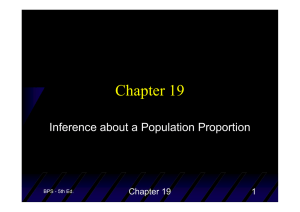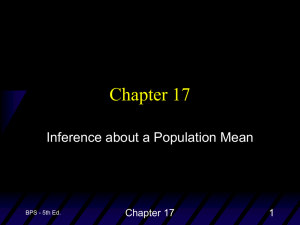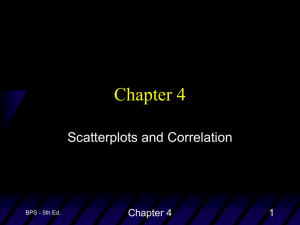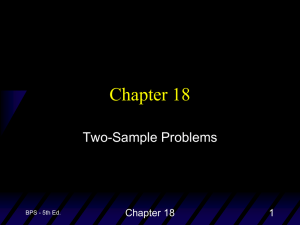Chapter 19
advertisement
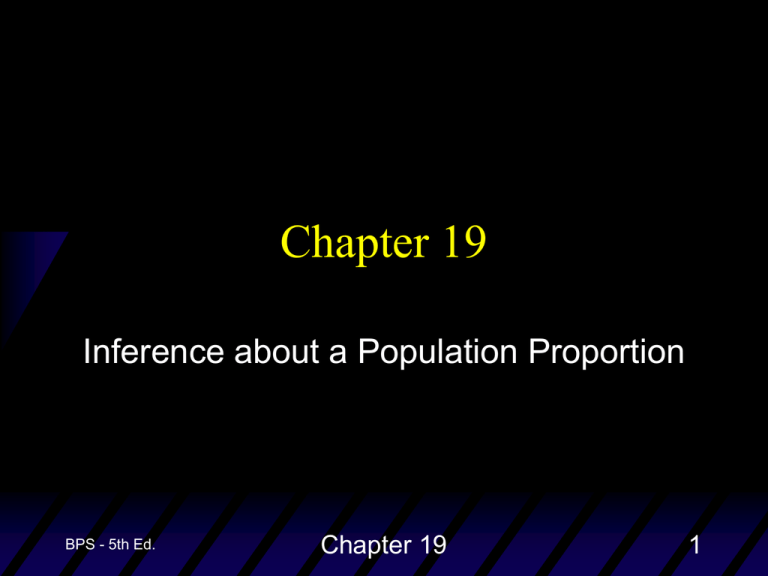
Chapter 19 Inference about a Population Proportion BPS - 5th Ed. Chapter 19 1 Proportions The proportion of a population that has some outcome (“success”) is p. The proportion of successes in a sample is measured by the sample proportion: “p-hat” BPS - 5th Ed. Chapter 19 2 Inference about a Proportion Simple Conditions BPS - 5th Ed. Chapter 19 3 Inference about a Proportion Sampling Distribution BPS - 5th Ed. Chapter 19 4 Standardized Sample Proportion Inference about a population proportion p is based on the z statistic that results from standardizing pˆ : – z has approximately the standard normal distribution as long as the sample is not too small and the sample is not a large part of the entire population. BPS - 5th Ed. Chapter 19 5 Building a Confidence Interval Population Proportion BPS - 5th Ed. Chapter 19 6 Standard Error Since the population proportion p is unknown, the standard deviation of the sample proportion will need to be estimated by substituting for p. BPS - 5th Ed. Chapter 19 7 Confidence Interval BPS - 5th Ed. Chapter 19 8 Case Study: Soft Drinks A certain soft drink bottler wants to estimate the proportion of its customers that drink another brand of soft drink on a regular basis. A random sample of 100 customers yielded 18 who did in fact drink another brand of soft drink on a regular basis. Compute a 95% confidence interval (z* = 1.960) to estimate the proportion of interest. BPS - 5th Ed. Chapter 19 9 Case Study: Soft Drinks We are 95% confident that between 10.5% and 25.5% of the soft drink bottler’s customers drink another brand of soft drink on a regular basis. BPS - 5th Ed. Chapter 19 10 Adjustment to Confidence Interval More Accurate Confidence Intervals for a Proportion The standard confidence interval approach yields unstable or erratic inferences. By adding four imaginary observations (two successes & two failures), the inferences can be stabilized. This leads to more accurate inference of a population proportion. BPS - 5th Ed. Chapter 19 11 Adjustment to Confidence Interval More Accurate Confidence Intervals for a Proportion BPS - 5th Ed. Chapter 19 12 Case Study: Soft Drinks “Plus Four” Confidence Interval We are 95% confident that between 12.0% and 27.2% of the soft drink bottler’s customers drink another brand of soft drink on a regular basis. (This is more accurate.) BPS - 5th Ed. Chapter 19 13 Choosing the Sample Size Use this procedure even if you plan to use the “plus four” method. BPS - 5th Ed. Chapter 19 14 Case Study: Soft Drinks Suppose a certain soft drink bottler wants to estimate the proportion of its customers that drink another brand of soft drink on a regular basis using a 99% confidence interval, and we are instructed to do so such that the margin of error does not exceed 1 percent (0.01). What sample size will be required to enable us to create such an interval? BPS - 5th Ed. Chapter 19 15 Case Study: Soft Drinks Since no preliminary results exist, use p* = 0.5. Thus, we will need to sample at least 16589.44 of the soft drink bottler’s customers. Note that since we cannot sample a fraction of an individual and using 16589 customers will yield a margin of error slightly more than 1% (0.01), our sample size should be n = 16590 customers . BPS - 5th Ed. Chapter 19 16 The Hypotheses for Proportions Null: H0: p = p0 One sided alternatives Ha: p > p0 Ha: p < p0 Two sided alternative Ha: p p0 BPS - 5th Ed. Chapter 19 17 Test Statistic for Proportions Start with the z statistic that results from standardizing : Assuming that the null hypothesis is true (H0: p = p0), we use p0 in the place of p: BPS - 5th Ed. Chapter 19 18 P-value for Testing Proportions Ha: p > p0 Ha: p < p0 P-value is the probability of getting a value as large or larger than the observed test statistic (z) value. P-value is the probability of getting a value as small or smaller than the observed test statistic (z) value. Ha: p ≠ p0 P-value is two times the probability of getting a value as large or larger than the absolute value of the observed test statistic (z) value. BPS - 5th Ed. Chapter 19 19 BPS - 5th Ed. Chapter 19 20 Case Study Parental Discipline Brown, C. S., (1994) “To spank or not to spank.” USA Weekend, April 22-24, pp. 4-7. What are parents’ attitudes and practices on discipline? BPS - 5th Ed. Chapter 19 21 Case Study: Discipline Scenario Nationwide random telephone survey of 1,250 adults that covered many topics 474 respondents had children under 18 living at home – results on parental discipline are based on the smaller sample reported margin of error – 5% for this smaller sample BPS - 5th Ed. Chapter 19 22 Case Study: Discipline Reported Results “The 1994 survey marks the first time a majority of parents reported not having physically disciplined their children in the previous year. Figures over the past six years show a steady decline in physical punishment, from a peak of 64 percent in 1988.” – The 1994 sample proportion who did not spank or hit was 51% ! – Is this evidence that a majority of the population did not spank or hit? (Perform a test of significance.) BPS - 5th Ed. Chapter 19 23 Case Study: Discipline The Hypotheses Null: The proportion of parents who physically disciplined their children in 1993 is the same as the proportion [p] of parents who did not physically discipline their children. [H0: p = 0.50] Alt: A majority (more than 50%) of parents did not physically discipline their children in 1993. [Ha: p > 0.50] BPS - 5th Ed. Chapter 19 24 Case Study: Discipline Test Statistic Based on the sample n = 474 (large, so proportions follow Normal distribution) no physical discipline: 51% – .50(1 .50) 0.023 – standard error of p-hat: 474 (where .50 is p0 from the null hypothesis) standardized score (test statistic) z = (0.51 - 0.50) / 0.023 = 0.43 BPS - 5th Ed. Chapter 19 25 Case Study: Discipline P-value P-value = 0.3336 pˆ : 0.431 z: -3 0.454 0.477 0.500 0.523 -2 -1 0 1 0.546 2 0.569 3 z = 0.43 From Table A, z = 0.43 is the 66.64th percentile. BPS - 5th Ed. Chapter 19 26 Case Study: Discipline 1. Hypotheses: 2. Test Statistic: 3. P-value: 4. Conclusion: Since the P-value is larger than a = 0.10, there is no strong evidence that a majority of parents did not physically discipline their children during 1993. BPS - 5th Ed. H0: p = 0.50 Ha: p > 0.50 P-value = P(Z > 0.43) = 1 – 0.6664 = 0.3336 Chapter 19 27

